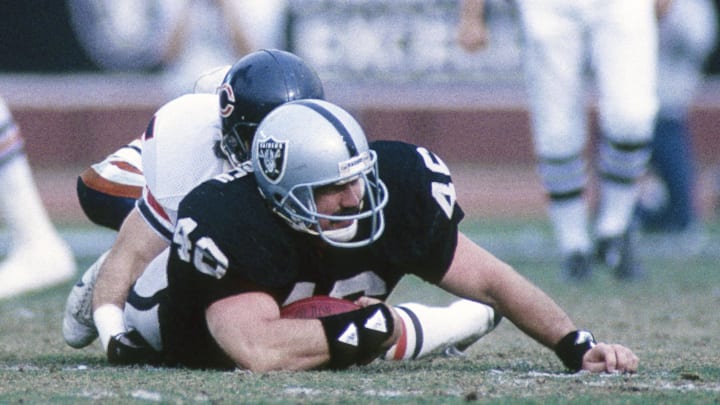The Case for Todd Christensen in the Hall of Fame, Pt. 2

Not too long ago, NFL writer and Hall of Fame selection committee Rick Gosselin spoke with our Hondo Carpenter Sr. They discussed the case for Oakland/Los Angeles Raiders tight end Todd Christensen to be enshrined into Canton.
"I think Todd Christensen is a player that deserves consideration, deserves discussion in the Hall of Fame," Gosselin said. "And that's the problem I have with the selection process -- we don't cycle enough people through the room. For whatever reason. I know two of the factors. I know two of the factors. 75 percent of all players in the Hall of Fame made All-Decade. Todd didn't make All-Decade. 64 percent won championships. Todd did win championships. ... He was in that bridge era of tight ends that moved from blockers to pass catchers. Charlies Sanders, Ozzie Newsome, Kellen Winslow, Todd Christensen. And he's the one guy that's fallen through the cracks."
Christensen did not make the All-1980s teams. But should he have? Winslow was selected first-team. Newsome was selected second-team. Comparing Christensen's decade with Winslow and Newsome, only seasons from the 1980s, there is an argument he should have contended for, at the very least, the second-team nod.
It is hard to argue against Winslow. He led the decade with 6,486 yards, as well as 516 receptions. But he has the same number of All-Pro nods as Christensen, with four. They both have the same amount of 1,000 yard seasons, three.
Christensen's best four-year stretch, 1983-1986, yielded more receiving yards than Winslow's best stretch from 1980-1983. Christensen had 4,394 yards (which was the best by any tight end in a four-year stretch heading into the 2010s), Winslow had 4,258. In that stretch, Christensen also became the first player, wide receiver or tight end, to have four consecutive 80 reception seasons. Winslow had three 80 reception seasons, non-consecutively.
Christensen became the first tight end to reach 90 receptions when he caught 92 in 1983. He would do it again in 1986, breaking his own record with 95. Both seasons, he was league leader in receptions. Winslow led the league in receptions twice, too, but he never reached the 90-catch milestone.
If Christensen was relatively comparable to Winslow, who was clearly the No. 1 tight end of the decade, than he had more than enough of a case to make second-team All-Decade. Newsome had just two 1,000 yard seasons to Christensen's three.
Newsome never led the league in receptions, Christensen did twice.
Christensen had more touchdowns, 41, to Newsome's 34. Christensen was selected to five Pro Bowls, in an age when that still carried weight, Newsome was selected to three. Christensen and Newsome were both four-time All-Pro selections, Christensen earning first-team honors twice and Newsome just once.
Newsome never reached 90 receptions, falling just short twice. He never had double-digit touchdown receptions, Christensen had a season of 12 in 1983.
Consider Christensen's trailblazing four-consecutive 80 reception seasons. Christensen and Newsome have the same number of 40 reception seasons with six. Winslow has seven. Christensen averaged 12.7 yards per reception. Throughout the decade, Newsome only averaged 11.7. Winslow fell short of Christensen with 12.6 yards per reception.
In 1986, Christensen finished fifth in AP Offensive Player of the Year voting. Neither Winslow nor Newsome finished in the Top 5 for the award.
As I mentioned in Part 1, Christensen never played with a Pro Bowl quarterback. Jim Plunkett had his resurgence, but did not secure the honor. Marc Wilson was far from such an accolade.
Winslow had one of the great quarterbacks of the era in Hall-of-Famer Dan Fouts. Fouts made six Pro Bowls, was All-Pro four times. He was AP Offensive Player of the Year in 1982. It should be noted that Winslow and Fouts benefited from "Air Corryell", head coach Don Corryell's innovative air raid passing attack. Christensen played in a balanced offense.
Winslow played with Bernie Kosar, who made a Pro Bowl and finished third in AP Offensive Player of the Year voting in 1987.
Christensen was also a vital brick in the wall that blocked for rushing leader Marcus Allen in 1985. Allen's 1,759 yards were the eighth-best in a single season to that point. Winslow and Newsome never blocked for a league-leading rusher. It should be noted that Christensen still managed to be a weapon all his own, too. He earned first-team All-Pro honors that season, reeling in 82 receptions for 987 yards and six touchdowns.
Gosselin mentioned the importance of winning championships, which goes without saying. Christensen has two Super Bowl rings. Winslow and Newsome never so much as played in the big game.
Christensen had just as good a decade as his two peers, the two best tight ends of his era. He had a strong case to be, at the very least, the second-team All-1980s tight end.
That Christensen was worthy of the second-team nod, and was comparable to Newsome and Winslow begs the question as to how he is not in the Hall of Fame. What also lingers is the question of how Christensen has not even made the semi-finalist or finalist ballot.
Ensure you follow on X (Twitter) @HondoCarpenter and IG @HondoSr and never miss another breaking news story again.
Please let us know your thoughts when you like our Facebook page WHEN YOU CLICK RIGHT HERE.
